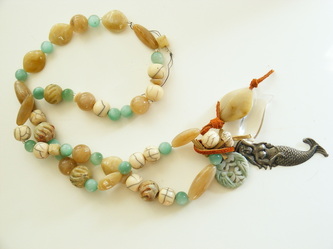
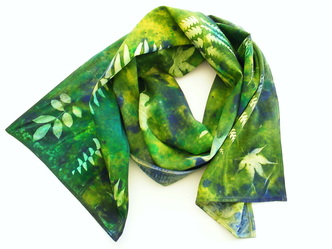
|
My sister, nieces, and I are starting a new endeavor. We have created a business, called Il Bianco Gallo (The White Rooster in Italian)(yes, we've been told it should be Gallo Bianco, but hey, we're Italian-American).  Mermaid's Treasure necklace We are selling handcrafted jewelry and accesories, and will be adding home decor, indoor and outdoor sculpture, and all kinds of handmade, vintage, salvaged, revamped, refitted, shabby chic, and generally cool stuff. So far, my sister Ann makes the most of the jewelry and accessories; my niece Amy is the Webmaster, jewelry-maker, bottle-washer, and mastermind; my niece Molly makes this awesome industrial jewelry (that's going to sell out as soon as it's posted); and I crack the jokes. Well, okay, I made the scarf below, and a few other things, but don't let that scare you off.  Rainforest Ferns hand-dyed scarf The website link appears below the picture, if you want to look out our wares. We will adding new stuff every week, so check back to see what's new. http://www.ilbiancogallo.com/
0 Comments
After I began painting The Dresses series, I read My Mother’s Wedding Dress, by Justine Picardie, and Love, Loss, and What I Wore, by Ilene Beckerman. Both are memoirs, a history of the self through clothes. Both writers focused on specific outfits, rather than the iconic, archetypal dresses I’m trying to paint. They talked about some particular garment, and what was happening in their lives when they wore it – what it meant to them, at the time, and after the fact, when they were looking back. In these paintings, I am looking for something universal, not just something I wore that was unique to me. Something I actually wore can tell stories about what happened to me, it’s true. But there are things I never got the chance to wear, and dreams that never came true. Maybe “empty” dresses can speak more eloquently about all the things that didn’t happen, all the experiences I never had. 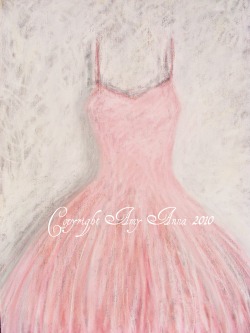 Everything is beautiful at the ballet. Isn’t it? Does any dress translate the word “yearning” better than the tutu? My niece took ballet to fulfill her physical education requirement at school. At the end of the semester, she had to put together a little dance sequence using some of the moves she learned in class. I had bought a three-layer, pink tulle ballet skirt to use as a “model” for some of my paintings. I loaned it to her for the class final. She loved wearing it. That did not surprise me – I’ve been thinking a lot about the power of clothes, so I expected that. What surprised me was that all the other students in the class felt the pull, and borrowed it for their final dances, too. This was not a class full of “bunheads,” future ballerinas, just a bunch of kids trying to get the credits that they needed. I could tell by the way she spoke about it that wearing that skirt made such a difference to the way they felt doing their dances. It just had magic. Afterwards, we talked about how anyone can buy a tutu and dance around the house, if they want to. But no one ever does. And it wouldn't be the same as actually wearing a pink tulle skirt and dancing in front of an audience. Maybe that skirt holds the key to the magic of a ballet dream – without the blisters. And everything is beautiful at the ballet . . . . 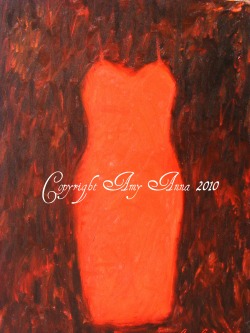 At art school I learned that pink is a tint of red, meaning that pink is just red with white in it. You use the same pigment for both. Yet I cannot imagine two colors further apart in terms of emotional connotations. Pink is all sweetness and light and softness and cuteness, and red is hey-the-engine-is-hot-let’s-take-a-ride-come-on-and-do-it-right-now. Enough said. This painting is called “Voodoo.” For years I have been looking for “the” color book that would tell me how to use color to create the emotional effects I wanted in my paintings. I think I may be not color-blind, but color-inhibited. I think we all are in this
culture. Go somewhere public and look around at what people are wearing. It’s a sea of grey, beige, and black. Lots of black. Black is supposed to be so chic, but what it really is, is boring and safe. It’s the ultimate camouflage. Diana Vreeland, editor of Vogue magazine in the 60’s, traveled to India and observed, “shocking pink is the navy blue of India.” Our landscape does not look like India, and I suspect that's partly why we dress in such dull colors (especially in the winter). It’s some sort of leftover adaptive behavior from the days when we used to be prey – don’t stand out, you’ll get munched. Maybe it still works, against human predators. Unfortunately, this leaves us all color-starved. In light of the pink versus red enigma mentioned above, if we are color-starved, are we emotionally starved, too? Are we range-of-experience-starved? The only book I could find that might be useful was Louise Hays’ Colors and Numbers. So I started researching the emotional effect of colors not by painting them, but by wearing them. The idea was to literally, physically immerse myself in a single color of clothing each day, over a long enough period of time to decide what effect it had on my emotions. Here is what I found. Wear yellow when you want or need to be sociable, like going to a party. Wear red when you are scared or insecure and need courage (interesting in light of Stephen Crane’s The Red Badge of Courage). Wear orange when you have a lot to do and need energy. Because it seems to assist activity and being busy, it would probably be a good color to paint your office. Dark blue is a very inward color – wear it when you need time to yourself. The effects of green and blue vary according to the shade. By chance, my husband and I bought these very dark grey sheets (they were on sale). It was awesome to sleep on them because it was like slipping into the void every night, but in a good way. Can color cure insomnia? If I was brave, I might paint or decorate my bedroom all black. I am still investigating. Does any of this translate to painting? If I paint a mostly yellow painting, will it arouse a feeling of conviviality? I have no idea. Do you? 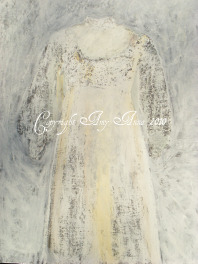 The Dresses Some articles of clothing have a power far beyond how often they are worn. In fact, it seems that the fewer times one wears something, the greater its influence. The wedding dress is the most obvious example – there are entire TV series devoted to the subject of finding the perfect gown. I imagine that this is so because some garments embody our deepest wishes and dreams: if the dress is just right, then the marriage will be, too. It is a form of magical thinking. Thus explaining it, does not, however, lessen how powerful the pull of the perfect garment can be. There’s more to it than that, though. I think certain kinds of dresses represent deep archetypes, and while we can discuss what these dresses mean all the day long, there are profound subterranean psychological attractions going on about clothing that can never be dissected. I recently started painting dresses. I didn’t realize that I was painting what is known in the art world as “still life”; I thought I was creating figure paintings, just without the people in them. After all, to my mind, I wasn’t painting the dresses as dresses, I was painting the states of mind they represented. My subject wasn’t the dress itself; it was the way it feels to wear certain kinds of clothes. (I discovered this is impossible, or at least, I am not skilled enough to do it. So then I thought, well, I’ll just paint The History of Femininity through Dresses. As if that would be easier. I have settled for the understanding that sometimes as an artist, one has no idea what one is doing, one just has to do whatever it is one is doing as best as possible, get on with the painting, and leave the philosophizing for some very empty day in the far distant future. Yet here I am, still philosophizing.) 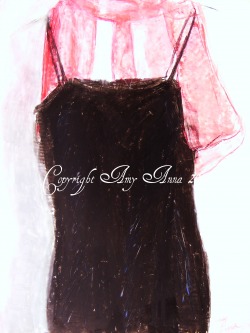 If I say to you, “Little Black Dress,” you not only know exactly what I am talking about in terms of style, you know the mood that goes with it: sophisticated, elegant, sexy. Glamorous. When I painted “Little Black Dress,” the first of this series, I realized that by leaving out the model and just painting the dress, I had made it Everyone’s Dress. I can’t necessarily see myself wearing the same dress as some beautiful model, but I can substitute myself for an invisible woman. And then I can imagine what it feels like to wear that beautiful dress. Perhaps I can do this even if I never actually wear that beautiful dress. How many people’s lives are glamorous? 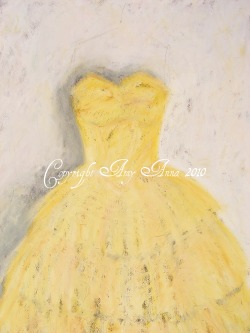 Second in influence to the wedding dress must be the prom dress. I think a lot of unexcavated dreaming about the future gets tied up with prom dresses. There is a coming of age element with the prom dress that I think has already passed by when you get to the wedding dress. There is something heartbreaking about prom dresses. Maybe it is more of that magical thinking; when I put this on, I will no longer have to worry about my skin and my hair will look like I meant it to do that and I won’t feel so stupid all the time. That’s the looking forward part. There’s a looking back part, too, depending on the phase of your life span. The looking back part says Jesus I was just so terribly young. That’s why so many artists (I am not blazing the trail here) are painting frilly, poufy 1950’s prom dresses. Those dresses embody that youngness so much more obviously than the prom dresses we actually wore. Those fluffy frills speak so clearly about how youth lifts off in the slightest of breezes and blows away. Forever. Loss and yearning. One dress can paint one thousand emotions. One dress can encompass so many dreams. Young girls want to be sexy. Old girls want to be young. |
AuthorHi, I'm Amy Anna, and I'm an artist, photographer, and writer. I'm a Person of Unrelenting Curiosity, so come explore with me. Archives
October 2015
Categories
All
|